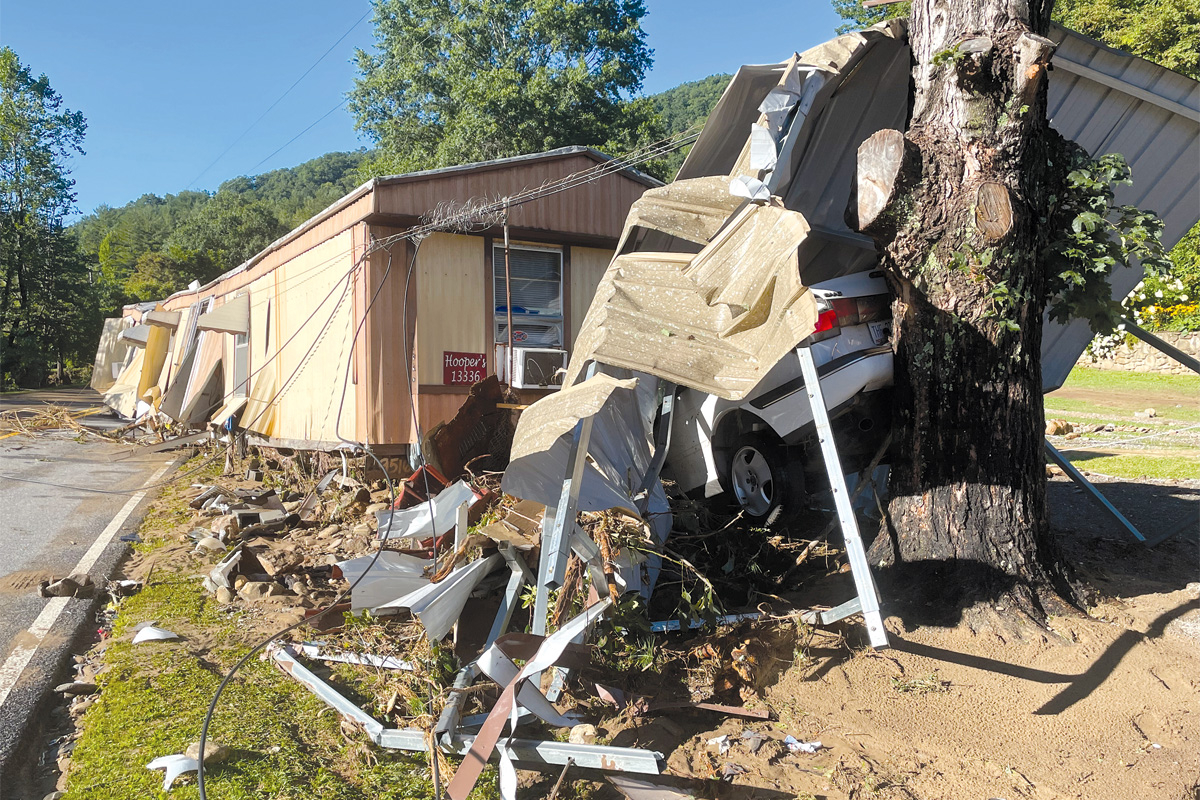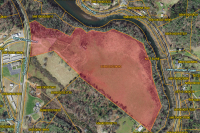From risk to resiliency: State waters summit highlights red tape, funding deficiencies
 Floodwaters from the Pigeon River tossed mobile homes and cars around like toys in 2021. Scott McLeod photo
Floodwaters from the Pigeon River tossed mobile homes and cars around like toys in 2021. Scott McLeod photo
An annual waters summit hosted by a pair of North Carolina congressmen brought together local, state and federal administrators, experts and elected officials who spent a lot of time looking back at the sad recent legacy of flood control, mitigation and recovery efforts in the state — hampered by funding anxiety, ensnarled in bureaucracy, stressed by the impact of growing populations on aging infrastructure and impeded by way too many government agencies on way too many levels that are all somehow siloed yet still tangled up like fallen trees in a raging river.
“This is a North Carolina issue, and it’s bringing out leadership across partisan lines,” said Canton Mayor Zeb Smathers, who attended the Greenville summit and participated in one of the panel discussions. “I think this is the issue of our time.”
The issue is complicated, but North Carolina’s General Assembly is putting a lot of hope in a forward-looking blueprint so that if the dollars appear and the red tape disappears, governments will be able to act.
“If all we do is talk about this,” said Congressman Greg Murphy (R-Pitt), “then we should all go home.”
Flooding happens in different ways in different areas across North Carolina, but its impact on the state’s number one industry, agriculture, affects everyone.
Even though agriculture isn’t a huge industry in Haywood County, streets were strewn with hundreds upon hundreds of beautiful, ripe green peppers after deadly flooding tore through Bethel, Canton, Clyde and Cruso in August 2021.
Related Items
With catastrophic flooding becoming more frequent, the substantial amount of land held by agrarian concerns large and small could hold the key to mitigation that would save lives, save millions of dollars and help thousands downriver, including in rural Haywood County.
“The river floods a lot more than it used to. No doubt about it,” said Lawrence Davenport, a Pitt County native and fourth generation farmer who lives on the Tar River.
When Davenport built his home in 1976, he measured the depth of the river at 24 feet. In 2016, he measured the depth at 16 feet. It used to take 5 or 6 inches of rain to flood the river near his home. Now, Davenport says, it’s only 2 or 3 inches. He estimates a third of the river’s carrying capacity has vanished.
The main culprit is sediment, and farmers like Davenport find themselves at the forefront of debris and sediment management.
Dredging, Davenport said, has become a dirty word in North Carolina. While it’s great for keeping waterways clear, studies show that it’s also devastating to local ecology, so it’s not always a viable solution.
Mitigation strategies like field borders, riparian buffers, livestock exclusion zones, reforestation efforts and cover crop programs have all contributed to a reduction in sedimentation, but they’re still not enough, according to David Williams, director of the N.C. Department of Agriculture’s Soil and Water Conservation division.
Keith Larick, the natural resources director for the N.C. Farm Bureau Federation, thinks there’s an opportunity to combine water storage with flood control measures, on-site. In 2011, North Carolina authorized the AgWRAP program, which helps small agricultural operators making less than $250,000 a year implement best practices on their land.
Those best practices include agricultural water storage strategies, like the creation of farm ponds.
Implementation funding is reimbursable, so applicants have to come out-of-pocket at least for a time. Projects are mostly capped at $75,000 or $100,000, with a 10% to 25% match for the applicant. Then, there’s the application and permitting to handle.

Trapped in a log cabin just off Cruso Road, Natasha Bright could do little more than watch as deadly floodwaters surged. Natasha bright photo
Larick told Congressman David Rouzer (R-New Hanover) that streamlining the whole process could be beneficial, especially with the Army Corps of Engineers, which is responsible for protection of many of the nation’s waterways.
“I’ve seen some projects in other states where when a farmer wants to build a pond they can go to the Corps, they can demonstrate, ‘Here’s this water resources need that I have,’ and in many cases that pond is exempt from permitting, or it is a very straightforward permitting process,” said Larick.
Rouzer said that his efforts in Washington, D.C. were already directed at the “weaponization of permitting” that has slowed or stopped projects in the energy sector, but he also acknowledged the lack of a task force approach, whereby all the players understand exactly how that streamlining must take place on the federal and state level so local-level implementations can take place.
“And keep in mind,” Rouzer said, “we weren’t thinking along these lines until relatively recently, because of what we’ve experienced and what we’ve endured from a flooding standpoint the last 20 years or so.”
It’s over the course of those 20 years that many of the flood control projects of the 1950s and 1960s approached the end of their service lives. When some of those dams, berms and levies were built, North Carolina’s population was around 4 million. Today, it’s approaching 11 million.
John Langdon, a Benson native, farmer and chair of the North Carolina Soil and Water Commission points to infrastructure as a lingering weakness.
“The DOT does a really good job of designing and building roads and bridges,” Langdon said. “But it appears that in rural America, we’re not doing as good a job of maintaining those drainage ditches and keeping the culverts [clear] so that small events don’t create a large event.”
Williams said that while bureaucracy had been a barrier to rehabilitating old flood control measures and building new ones, like paying farmers to take on stormwater and then release it after the flood, so had funding.
“I’ll go back to the water farming, for instance. Right now, we have no funding mechanism for water farming,” Williams said. “That can play such an important role in how we go forward with using the ag land base to benefit everybody, the communities downstream. And the farmer needs to benefit from it, too.”
A pair of experts from Louisiana, Mark Harrell and Brandon Waggoner, shared their success stories in mitigating both coastal and inland flooding, but expressed worry over federal funding as populations naturally increase. Harrell, the recently retired director of the Livingston Parish Office of Homeland Security and Emergency Preparedness, testified to Louisiana’s population growth and its effect on flood control.
“Huge,” Harrell said. “The runoff from all the development is hurting everything we have.”
Waggoner, director of the Tensas Basin Levee District in northeast Louisiana, offered a different perspective on dredging.
“’Dredge’ is a good word in Louisiana. We want dredging dollars, and the president puts it in budgets, and we like it,” he said, drawing applause from the 200-person audience. “It’s not an ugly word where I’m from.”
But it all comes down to funding. If and when they’re available, federal funds usually trickle down to states, but availability isn’t the only obstacle.
Murphy echoed Rouzer’s disdain for the bureaucracy that officials in Haywood County know all too well; currently, there are no less than 19 different federal departments or agencies with funding streams for mitigation, resiliency and recovery.
“Primarily, the flood control measures that we have in our area were put there by the Corps of Engineers,” Waggoner said. “One of the problems that we run into is that the Corps has lack of funding … If it’s built by federal dollars and they’re not helping to keep it up, then that falls back on our state.”

When waters finally receded, Natasha Bright was left to survey the damage inside her Cruso home. Natasha Bright photo
Most Corps projects begin with a study to ensure they’re feasible, justified and environmentally acceptable. A new policy calls for delivery of these studies in less than three years for less than $3 million. Murphy asked Brett Walters, chief of the Corps’ planning branch, if that could be expedited.
Large projects over $20 million, Walters said, must pass through a chain of command, from the assistant secretary of the Army through the Health and Human Services Department’s assistant secretary for administration to the Office of Management and Budget and then on to Congress for authorization.
“Without Congress making changes, I don’t see how that could be accelerated very much,” said Walters.
Murphy reiterated the importance of the ultimate level of legislative involvement — appropriations.
“You can authorize everything in the world,” Murphy said, “but if you don’t pay for it, it never happens.”
With trepidation about funding flowing through nearly every segment of the summit, ensuring each dollar spent creates lasting change is critical.
Lessons learned from Louisiana to Haywood County will all contribute to a unique $20 million decision support tool called the North Carolina Flood Resiliency Blueprint, which could make North Carolina a national leader in flood resiliency.
“The blueprint is designed to unify all the existing resources and knowledge we have, all the existing data and mapping and tools that different agencies at different levels of government have developed, and putting them all in one place so that we can have a better view on what the actual situation is and put that data in the hands of folks who are making decisions,” said Elisabeth Biser, secretary of the N.C. Department of Environmental Quality.
Legislators outlined the directive in the 2021 budget and allocated nearly $100 million available to DEQ upon completion of the draft blueprint, which was presented on Jan. 19 .
Work has already begun in the Neuse River basin with a pilot program designed to gauge effective and efficient utilization of data from the blueprint.
The immediate focus will be on basin-specific strategies in basins vulnerable to tropical storms and hurricanes — Cape Fear, Lumber, Neuse, Tar-Pamlico and White Oak — as well as Western North Carolina’s French Broad River basin, which is affected not only by tropical storms and hurricanes but also by heavy rains.
As reported in the N.C. Tribune, during a Hurricane Response and Recovery subcommittee meeting the day before the summit, Haywood County Rep. Mark Pless had some apprehension he further outlined in a Jan. 26 constituent newsletter.
“The blueprint when fully functional will help guide federal, state and local governments and even citizens in preventing the destruction we saw just 2 years ago with Tropical Storm Fred,” wrote Pless, who also attended the summit. “However, I do have concerns about the implementation of the blueprint. My first concern is how do we keep it from being a regulatory tool. It is intended to be a resource tool only. I am assured it will remain as that, but I do have reservations.”
Sushma Masemore, assistant secretary for environment with NCDEQ, emphasized during the summit that the decision support tool would not be used as an apparatus of state control.
“The blueprint or DEQ is not in the decision-making role,” Masemore said. “We are not making those final decisions. The tool is going to provide the access to information. It is up to that local entity or project developer to then translate that [data] into a submission, perhaps it’s through a grant program or through the funding that the legislature has provided.”
Pless, in his second term, found himself thrust into the center of the storm during Haywood County’s 2021 flood. Consequently, he also found himself charged with finding the funding to help hard-hit areas recover.
“My second concern is how much money it will take to see a reduction in flooding,” Pless added. “I will continue to weigh the costs verses benefit as this moves forward.”
An online beta version of the tool is expected sometime in April and will couple street-level flooding data with a spending dashboard and information on funding sources, all of which should make it easier to illustrate the return on investment.

The rising sun paints an ugly scene at Pisgah High School’s Memorial Stadium. Greg Boothroyd photo
“It’s not enough just to create the tool,” Biser said. “We need to make sure that people have resources to be able to implement strategies that are going to help their communities become more resilient.”
With the right resources, the tool could prove useful as Canton ponders decisions not yet made on myriad issues it still faces.
Smathers, during a panel discussion of local government leaders moderated by Murphy, recounted the difficult circumstances created during and after Canton’s second 500-year flood in less than two decades.
Shortly after the 2021 flood, the town embarked on projects it was able to, most recently a transformative mitigation strategy for where Bethel Christian Academy now sits (see BETHEL, p. 4).
The closing of the town’s century-old paper mill earlier this year could open up a huge swath of privately-owned riverside land downtown for any number of uses — the subject of much speculation.
“As we rebuild and reimagine Canton, and we literally have to rebuild a city, almost 180 acres … the only hill that I will die on is if we do not take advantage of tying flood mitigation into the future of the mill,” Smathers said. “Canton was built in a swamp. This mill was built in a swamp. Mother Nature is undefeated. We have to take this moment to find a place for the water to go, and look at what mitigation can serve as flood protection but also economic development.”













